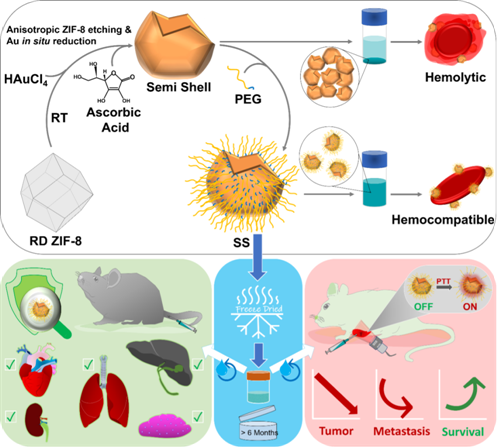Ministry of Science & Technology
A simplified method to synthesize nano-cups that can blaze the cancer with heat
Posted On:
17 JUN 2025 5:55PM by PIB Delhi
Researchers have developed a novel one-step colloidal synthesis method for nanoparticles with a unique shell structure with nano-cup morphology that is partly covered with polyethylene glycol (PEG) that can help with photothermal therapy (PTT) to treat cancer.
Conventional fabrication techniques of these so-called semi shells (SS) with nano-cup morphology are multi-step, labour-intensive, or require harsh etching agents like hydrofluoric acid at high temperatures and toxic precursors.
Scientists from the Institute of Nano Science and Technology (INST), Mohali, an autonomous institute under the Department of Science and Technology (DST), in collaboration with researchers from Advanced Centre for Treatment Research & Education in Cancer, Tata Memorial Centre (ACTREC) and Indian Institute of Technology Bombay (IITB), have developed a novel one-step colloidal synthesis method for fabricating PEGylated semi-shells (SS) with nano-cup morphology at room temperature.
The research published in Communication Chemistry, an open access Nature group journal involved optimizing synthesis parameters, characterizing optical and structural properties, and conducting extensive in vitro and in vivo assessments to confirm the therapeutic efficacy of SS.

Fig: Illustration of semi-shell formation using rhombic dodecahedron (RD) shaped ZIF-8 as a sacrificial template and its PEGylation-assisted blood compatibility, cryopreservation, systemic safety and on-demand reconstitution towards pronounced photothermal therapy of advanced cancer.
The simplified yet highly unique approach circumvents all the drawbacks of previously reported processes by using a biocompatible metal-organic framework (MOF), ZIF-8, as a sacrificial template. The synthesis employs mild reducing agents like ascorbic acid (Vitamin C) at room temperature.
The method also eliminates the need for specialized equipment. This innovation was achieved by simultaneously carving out the ZIF-8 crystal, a process known as ‘etching’ while gold nanoparticles grow in place of these etched ZIF-8 yielding SS with a strong absorption and scattering of light in the invisible near infra-red window of electromagnetic spectrum, which is ideal for highly effective photothermal therapy.
Surface passivation with PEG enhances cryo-preservability, aqueous stability, and blood compatibility of these SS, ensuring an extended shelf life and safe intravenous administration. The PEGylated SS synthesised, was nontoxic, had high photothermal conversion efficiency and was found to have high therapeutic efficacy.
They have shown that the SS is capable of destroying metastatic breast tumours through a medical procedure called photothermal ablation.
The procedure significantly improved survival rate and minimised tumour relapse in preclinical mice model indicating their potential to significantly improve outcomes in advanced breast tumours.
Compared to existing technologies, this method ensures superior stability, ease of administration, and enhanced photothermal performance. Future studies aim to explore chemo-photothermal therapy for highly selective oncological applications and investigate the potential of these semi shells in Surface-Enhanced Raman Spectroscopy (SERS) biosensing, leveraging their unique optical properties for advanced biomedical applications.
***
NKR/PSM
(Release ID: 2136980)
Visitor Counter : 87